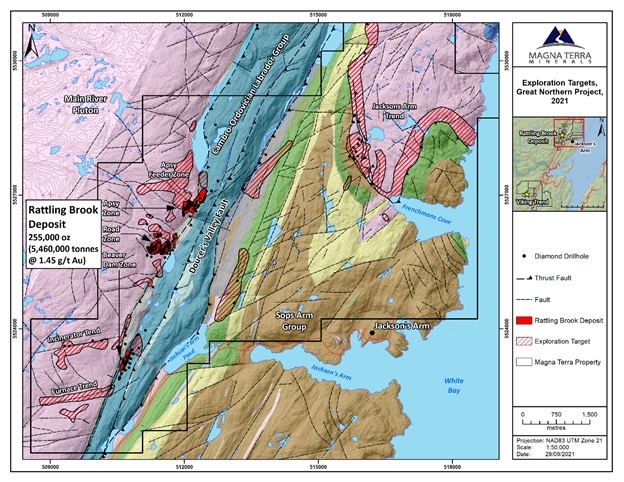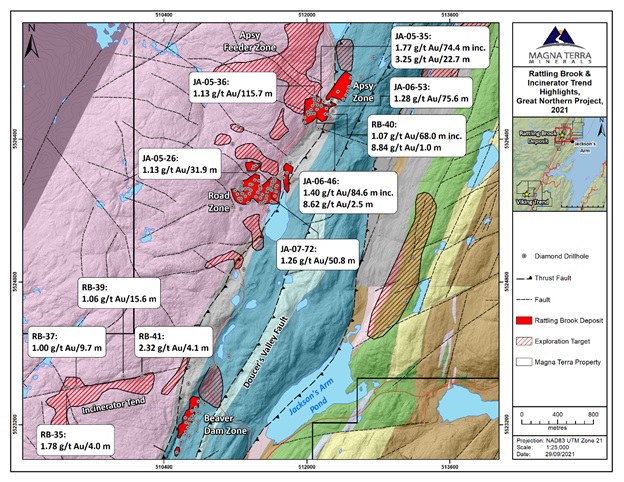Magna Terra Discovers New Gold Zone Over 800-Metre Strike and Expands the Rattling Brook Deposit - Intersects 1.30 g/t Gold Over 16.5 Metres - Great Northern Project, Newfoundland
By:
Magna Terra Minerals Inc. via
AccessWire
February 08, 2022 at 08:00 AM EST
TORONTO, ON / ACCESSWIRE / February 8, 2022 / Magna Terra Minerals Inc. (the "Company" or "Magna Terra") (TSXV:MTT) is pleased to announce that it has received assay results from its recently completed drilling program at the Rattling Brook Deposit (the "Deposit") on its 100% owned Great Northern Project ("Great Northern"), located in western Newfoundland (see news release dated November 22, 2021). Drilling consisted of 10 drill holes (JA-21-124 to 133) totalling 1,253 metres (the "Drill Program") and was designed to test potential geological controls on gold mineralization by northwesterly trending faults (Exhibit A and B). The Company has also received assays from a mapping and 79-sample prospecting program ("Surface Sampling Program") conducted along the same northwesterly striking fault zone referred to as the Apsy Feeder Zone. The Drill Program resulted in the discovery of a new zone of gold mineralization, confirming that northwesterly trending faults form favourable hosts to gold deposits. Specifically, gold mineralization was intersected 150 metres northwest of the Rattling Brook Deposit within the Apsy Feeder Zone, both expanding the deposit and confirming the presence of gold mineralization within the fault structures (Exhibit C and D). Further, the Surface Sampling Program resulted in 32% of rock grab samples** being anomalous in gold, including assays up to 14.7 grams per tonne ("g/t") gold and demonstrates along with previous sampling that gold mineralization within the Apsy Feeder Zone continues at surface over 800 metres of strike length (Exhibit A). Highlight gold intersections (see Table 1 below) from the Drill Program include:
"We are extremely pleased with the assay results from this drill program. We have discovered a new gold zone and confirmed a key geological control on mineralization demonstrated by intersecting thick zones of gold mineralization hosted within late faults, such as the Apsy Feeder Zone. The western most drill intercept within the Apsy Feeder Zone also demonstrates that the Rattling Brook Deposit likely extends at least 150 metres west of the current resource. Further, surface rock grab samples** with assays up to 14.7 g/t gold, together with previous sampling, indicate there is significant potential for resource expansion up to 800 metres along strike from the Rattling Brook Deposit with further drilling. Importantly, similar faults to the Apsy Feeder Zone are prevalent throughout the Great Northern Property and are coincident with similar geophysical characteristics, providing numerous additional opportunities for further discovery and resource expansion. Several of these are priority targets for follow-up drilling in 2022 and, in addition to the Apsy Feeder Zone, include targets such as the Incinerator and Furnace Trends as well as others on the district-scale Great Northern Project. The Drill Program and Surface Sampling Program have significantly impacted the prospectivity of the Great Northern Project and set the stage for further discovery and value creation throughout 2022." ~ Lew Lawrick, President and CEO, Magna Terra Minerals Inc. The Rattling Brook Deposit contains a NI 43-101 Inferred Mineral Resource^ comprising 255,000 ounces at 1.45 g/t gold (5,460,000 tonnes) and is hosted along a 5-kilometre section of the larger Doucers Valley Fault. The Deposit is hosted within three zones, the Apsy, Road, and Beaver Dam Zones, that are open for expansion at depth and along strike. A key controlling feature that has been identified are northwest and east-west striking fault zones that are thought to be potentially higher-grade feeder zones to the Rattling Brook Deposit. Several of these fault zones are not tested and drilling outside of the immediate resource area is sparse. Drill Program Details Drilling in holes JA-21-124 and 133 has successfully reproduced the thickness and tenor of sulphide mineralization and accompanying alteration compared with previous drilling in the area (e.g. JA-05-35 and 36). Drilling has also served to confirm the moderate southwest dip of the Apsy Zone. Drilling in drill holes JA-21-125 to 129 and 131, served to discover sulphide mineralization and alteration along the Apsy Feeder Zone, effectively expanding the footprint of the Apsy Zone 150 metres towards the northwest. Importantly, drilling in holes JA-21-131 and 129, which were drilled down-dip due to access issues, successfully intersected the Apsy Feeder Zone to a depth of 160 metres (~100 vertical metres). Drill holes JA-21-130 and 132 tested the up-dip extension to the north of the Apsy Zone Mineral Resource. Mineralization at the Apsy Zone comprises overall 1 to 3% (locally up to 10%) disseminated and stringer pyrite and arsenopyrite that is closely associated with pervasive sericite alteration. Alteration increases towards the lower contact of the moderately southwest dipping Apsy Zone, where it is marked by near complete replacement of the host granodiorite by sericite and silica often with hydrothermal brecciation of the host rock and a zone of intense shearing and faulting. These zones of more intense alteration are often associated with higher gold grades (> 2.0 g/t gold) in the Apsy Zone. Table 1: Highlight assay composites from the Apsy Drill Program
Notes: *Interval presented as core length only, please see TT in highlights above No significant assays in drill holes JA-21-125, 126 and 130 Previous (1986 to 2007) select drill intercepts that partly define the Apsy Zone adjacent to the area of the Drill Program include:
Surface Sampling Program Details The rock grab and float samples** assayed up to 14.7 g/t gold with 13 of the 79 rock samples assayed greater than 1.0 g/t gold and 19 rocks samples assaying greater than 0.5 g/t gold. The results of this prospecting program, together with historic soil sampling, support the potential for gold mineralization to continue to the northwest for 800 metres along the Apsy Feeder Zone where it has not been previously tested by drilling. **Grab and float samples are selected samples and are not necessarily indicative of mineralization that may be hosted on the property. Exploration Target Details
Apsy Feeder Zone and Apsy Zone (Rattling Brook Deposit) The Apsy Feeder Zone and associated fault, gold-bearing rock grab samples (assaying up to 14.7 g/t gold), and anomalous soils extends for 800 metres northwest of the Apsy Zone mineral resource. Recent drilling has extended the Apsy Zone 150 metres to the northwest along the Apsy Feeder Zone. Recent drill results from the Apsy Feeder Zone include 1.30 g/t gold over 16.5 metres (TT 7 metres) in drill hole JA-21-131; 1.64 g/t gold over 9.7 metres including (TT 9 metres), including 16.60 g/t gold over 0.5 metres in drill hole JA-21-127; and 0.72 g/t gold over 128.5 metres (TT 45 metres), including 1.27 g/t gold over 17.3 metres and 1.47 g/t gold over 7.0 metres in drill hole JA-21-129. These results correspond well with historic drilling at the Apsy Zone that includes 1.13 g/t gold over a core length of 115.7 metres (TT 70 metres) in drill hole JA-05-36 (Exhibit C and Exhibit D). Recently re-processed historic IP geophysical data outlines a high chargeability anomaly that corresponds with the known Apsy Zone Resource as well as the Apsy Feeder Zone. The IP chargeability target coincident with the Apsy Feeder Zone has not been tested by diamond drilling and represents an opportunity to further discover sulfide and gold mineralization along this Trend. Incinerator Trend
The altered and mineralized zone is hosted along an east-west oriented (070o) fault zone and associated topographic low (Exhibit A and Exhibit B). The fault zone, along with gold intersected in the four broad-spaced drill holes and gold-bearing soil samples, corresponds to a 1.0-kilometre long IP chargeability anomaly that forms a compelling target for follow-up drilling in the winter 2022. Furnace Trend Jacksons Arm Trend
Highlights of surface grab samples** include:
Several north and northeast oriented fault zones truncate the main thrust fault at Jacksons Arm in the area of multiple rock and soil gold occurrences and future work will focus on testing these fault zones for control on gold mineralization. **Grab samples are selected samples and are not necessarily indicative of mineralization that may be hosted on the property. About the Great Northern and Viking Projects The Projects are centered along a 20-kilometre section of the Doucer's Valley Fault, a significant geological control on, and host to, several gold deposits and untested prospects, including the Rattling Brook and Thor Deposits, Jacksons Arm, Little Davis Pond, Viking, and Incinerator Trends. Gold mineralization is hosted within a variety of rock types that include Precambrian or Ordovician granite and granodiorite, or younger volcanic and sedimentary rocks, typically along splays off the Doucer's Valley Fault. Alteration consists of mesothermal style sericite, quartz ± iron carbonate ± sulfide veins and stockworks with 2 to 5% total sulfides consisting of pyrite, arsenopyrite, galena, chalcopyrite, and sphalerite, and locally show trace amounts of visible gold. The Great Northern and Viking Projects are host to significant Current and Historic Mineral Resources, including:
Mineral Resources are not Mineral Reserves and do not have demonstrated economic viability. All Mineral Resource Estimates were prepared in accordance with NI 43-101 and the CIM Standards (2014). Please refer to the NI 43-101 Technical Report with effective date January 23, 2019 by Harrington and Cullen (2019) as detailed below for the Great Northern Project and the NI 43-101 Technical Report with effective date August 29, 2016 by Copeland et al. (2016). An Independent Qualified Person has not carried out sufficient work to classify the Thor Historical Mineral Resource Estimate as current and Magna Terra is not considering this Mineral Resource Estimate to be current. Magna Terra considers the Thor Deposit to have potential for expansion that will be addressed by the Company in future exploration programs. See further details on Technical Reports below. Pandemic Considerations Junior Exploration Assistance Grant Qualified Person and Technical Reports All NQ-sized drill core samples collected as part of this drilling program were collected using QA/QC protocols including the regular insertion of certified standards and blanks within each sample batch sent for analysis. Drill core and rock grab samples were sent to Eastern Analytical Limited in Springdale, NL and analysed for Au by fire assay (30 g) with an AA finish. ^The Mineral Resource Estimate quoted in this press release regarding the Great Northern Project refers to the technical report: "NI 43-101 Technical Report and Updated Mineral Resource Estimate on the Rattling Brook Gold Deposit, Great Northern Project, White Bay Area, Newfoundland, Canada", (the "Great Northern Report") with an effective date of January 23, 2019, and authored by Matthew Harrington, P.Geo. (Independent Qualified Person) and Michael Cullen, P.Geo. (Independent Qualified Person). ^^The Historical Mineral Resource Estimate quoted in this press release regarding the Viking Project (Thor Deposit) is taken from the technical report: "NI 43-101 Technical Report And Mineral Resource Estimate For The Thor Deposit, Viking Project, White Bay Area, Newfoundland and Labrador, Canada, Latitude 49o 42′ N Longitude 57o 00′ W" prepared for Anaconda Mining Inc. by David A. Copeland, P.Geo., Dr. Shane Ebert, P. Geo. and Gary Giroux, P. Eng. M.ASc., August 29, 2016. An Independent Qualified Person has not carried out sufficient work to classify the Thor Historical Mineral Resource Estimate as current and Magna Terra is not considering this Mineral Resource Estimate to be current. Magna Terra considers the Thor Deposit to have potential for expansion that will be addressed by the Company in future exploration programs. About Magna Terra Forward-Looking Statements Cautionary Statements Regarding Forward-Looking Information FOR FURTHER INFORMATION PLEASE CONTACT:  Exhibit A: Drill Plan Map of the Apsy Feeder Zone and Apsy Zone, Rattling Brook Deposit Area, Great Northern Project.  Exhibit B: Schematic Longitudinal Section (Looking North) through the Apsy Feeder Zone and Apsy Zone, Rattling Brook Deposit Area, Great Northern Project.  Exhibit C: Significant Gold Exploration Targets at the Rattling Brook Deposit and Jacksons Arm Trend.  Exhibit D: Plan Map of Select Drill Intercepts (core length), Mineral Resource Areas and Exploration Targets, Rattling Brook Deposit Area, Great Northern Project. SOURCE: Magna Terra Minerals Inc. View source version on accesswire.com: https://www.accesswire.com/687716/Magna-Terra-Discovers-New-Gold-Zone-Over-800-Metre-Strike-and-Expands-the-Rattling-Brook-Deposit--Intersects-130-gt-Gold-Over-165-Metres--Great-Northern-Project-Newfoundland More NewsView More
DoorDash’s Recent Stock Dip Equals 60% Upside ↗
November 23, 2025
Via MarketBeat
Tickers
DASH

Wall Street Loves Williams-Sonoma Right Now—Here’s Why the Stock Could Soar in 2026 ↗
November 23, 2025
Via MarketBeat
Tickers
WSM

Meta Wins FTC Fight, Keeps Instagram Growth Machine Intact ↗
November 23, 2025
Via MarketBeat
Tickers
META

Red Cups or Red Flags: Starbucks’ Bet on a Holiday Recovery ↗
November 23, 2025
Via MarketBeat
Tickers
SBUX

MP Materials Stock Soared After Earnings—Here’s the Real Reason ↗
November 22, 2025
Via MarketBeat
Recent QuotesView More
Stock Quote API & Stock News API supplied by www.cloudquote.io
Quotes delayed at least 20 minutes. By accessing this page, you agree to the Privacy Policy and Terms Of Service.
© 2025 FinancialContent. All rights reserved.
|